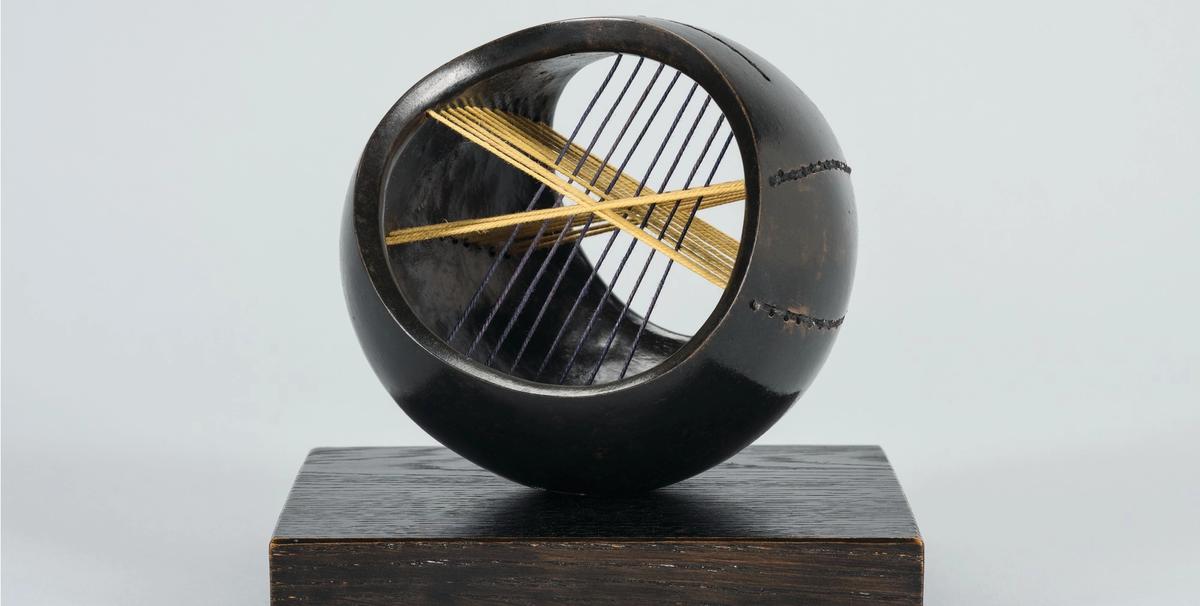People tend to associate the British artist Henry Moore (1898-1986) with the monumental bronzes for which he is famous. Words such as tiny, purple and yellow do not immediately spring to mind, but that is precisely what visitors to the San Diego Museum of Art’s new interactive Visible Vaults gallery can expect to find. One of the US museum’s latest acquisitions is a six-inch-tall bronze sculpture with purple and yellow strings from a small but important series of experimental stringed sculptures the artist made from 1937 to 1939.
The work consists of a bronze ball, with a hollowed-out centre, sitting on a square wooden base. The ball’s negative space is pierced with a series of crisscrossing strings. The piece was donated to the museum by the daughter of the collector Bernard Borkon, who bought the work from Moore in 1951 after seeing some of the artist’s stringed sculptures in his big exhibition at the Tate in London that same year. The work was recently taken to the Henry Moore Foundation in Perry Green in England by Anita Feldman, the museum’s deputy director for curatorial affairs and education to learn more about it and have it restored. She formerly worked at the artist’s foundation.
Stringed Ball (1939) was compared with a cast from the foundation and it was immediately apparent that the ball had shifted from its base and would need to be repositioned. When the foundation’s sculpture conservator James Copper removed a string, he noticed that the ends where it was fixed to the ball were not cream but a dark lavender that had faded over the years. He soon discovered that half of the strings were lavender and the other half were actually bright yellow. Fortunately, the foundation still has a box of lavender and yellow string that Moore dyed back in 1939 so the piece was restrung using original materials. “It’s so like Moore and the foundation to save absolutely everything,” Feldman says. “There is still a little more [of the original string] left—we didn’t use all of it,” she adds reassuringly. The treatment also included repatinating and polishing the bronze sculpture.
Letters Moore sent to Borkon in 1951 when he bought the work, including a request from the economical artist asking the collector to post back the box, state that Stringed Ball was a maquette for a work that Moore “tried to carry out on a larger scale, but the larger version got destroyed”. There is no mention of the larger version in the foundation’s archives; Feldman wonders if the piece was in Moore’s London studio when it was bombed in 1940 during the Blitz. “It’s quite exciting because he didn’t make many enlargements of his stringed pieces,” she says. The next step, Feldman says, is to go through the foundation’s archives to see if photographs of the large version of Stringed Ball can be found.
Moore created between 20 and 30 stringed sculptures over a period of three years beginning in 1937. He championed the Republican cause during the Spanish Civil War (1936-39) through his involvement with the anti-Fascism group Artists’ International Association, and it was during this period that he made Spanish Prisoner (1939), a lithograph of a semi-abstract figure standing behind barbed wire that he intended to sell to raise funds for the Spanish exiles interned at detention centres in France. According to Feldman, the tension of the taut strings in Moore’s stringed sculptures originated in works condemning the plight of the refugees. “They show a mix of Surrealism and tension as Britain was about to enter the Second World War,” she says.
“At the end of the day, Moore was a humanitarian. His work was all about finding a way for Modernism to speak to the issues of mankind and humanity,” Feldman says. “There is something poignant about where we are today and where he was in 1939.” She says his motivation for making public sculpture was wanting art to be a part of people’s everyday lives. “He truly believed it could change communities and be a humanising influence,” she says. “These are the lessons for today, that the role of art in society is still relevant.”


